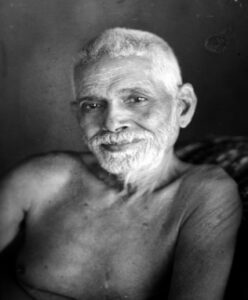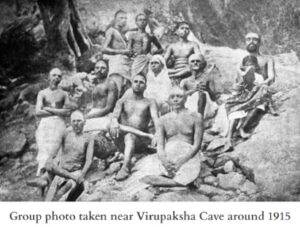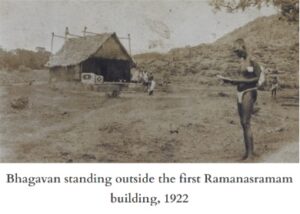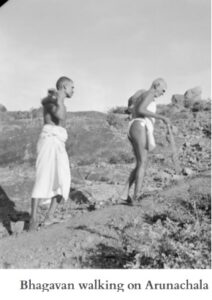
Ramana Maharishi is one of the most revered Hindu saints of the 20th century. His devotees also consider him to be an avatar of Shiva and would gather around him to have his darshan.
He had a great attraction towards the sacred Arunachala Hill and his teachings were influenced by the 63 Nayanars, a group of 23 Tamil Hindu saints who were devotees of Lord Shiva.
He lived on the Arunachala Hill after attaining sanyas and an ashram was built around him. His devotees would partake of his spiritual teachings and instructions by sitting silently beside him and asking questions.
Ramana Maharishi in his teachings promoted self-inquiry or awareness of self along with Bhakti or devotion and a surrender to the self.
Ramana Maharishi’s original name was Venkataraman Iyer and he was born on December 30, 1879, in the village of Tiruchuzhi, district of Virudhunagar in the state of Tamilnadu.
He is however revered as Bhagavan Sri Ramana Maharishi.
Ramana Maharishi’s early years and upbringing
Belonging to a Hindu family, he was the fourth child of Sundaram Iyer. Sundaram Iyer was from the lineage of the great Maharishi Parashara who was the author of many great Indian texts, like the first Purana the Vishnu Purana. His mother was Azhagammal, his two brothers were Nagaswami and Nagasundaram, and a younger sister Alamelu. His father was a court pleader which was a historical legal occupation. He had an auspicious birth. He was born at the exact moment that the decorated icon of Lord Shiva was re-entering the Bhuminatha temple during the festival of Arudra Darshanam celebrated in his hometown.
Born into a pious, middle-class family, he showed no inclination towards greatness in his childhood years. He was good at sports, average in studies, and a little bit mischievous. He however had three unusual traits.
• When he slept, he went into a deep state of unconsciousness and would not wake up even if his friends beat him.
• He was extraordinarily lucky. Whichever team he played for, always won. For this, he was called, ‘Tangakai’ Or golden hand.
• He was great at literary Tamil and would at times correct his Tamil language teacher.
Once when he was 6 years old he made boats out of legal papers belonging to his father and floated them in the river. When his father berated him, he left home and hid behind the statue of the Divine Mother in the temple. This shows how, even as a child he found solace in divinity.
The pivotal moment of his spiritual awakening at the age of 16
Ramana Maharishi’s father died when he was twelve and his family broke up. He and his brother went to live with his uncle in Madurai.
When he was 16 years old, Venkataraman had a near-death experience. He was sitting in his uncle’s house when he had a premonition that he was about to die. Instead of panicking he gathered his wits and began to analyze what was unfolding. He began to dwell on what constituted death. What would die with him and what part of him would live? This process of intense self-inquiry resulted in his spiritual awakening. This experience and awareness remained with him for life. It resulted in him being fully and finally liberated.
Some power took over Venkataraman and made him lie on the floor. But when he got up, the boy had turned into a fully enlightened sage.
Ramana Maharishi’s journey to the holy mountain of Arunachala
Several weeks passed after the incident and Ramana Maharishi found himself being pulled more and more inside his Self. Until finally one day he could bear it no more and he left home without telling anyone where he was going. He just left a note explaining that his true father was calling him and this he had undertaken a virtuous journey. He also advised that no money should be spent on searching for him. The father he referred to was Arunachala and his destination was the Arunachala hill which was a major pilgrimage center. It took him three days to reach Arunachala, but once he got there he never left.
Miracle at Arunachala or Tiruvannamalai
When Ramana Maharishi arrived at Arunachala he realized it was Tiruvannamalai. Normally the doors to the temple are closed and nobody is allowed inside during normal days. But when Ramana Maharishi stood before the shut doors, the doors opened by themselves one by one and he was able to go right up to the lingam and hug it. Ever since his spiritual enlightenment, the Maharishi had felt a burning sensation in his body. This was soothed only when he hugged the lingam and he felt at peace. This was the only time he ever visited the inner shrine. He later renounced all his worldly possessions, shaved his hair and stayed in a deep samadhi in various parts of the temple for several years. People who became his devotees cared for him, cleaned him and force-fed him to keep him alive.
The Mango Orchard of Gurumurtham
After some time he was invited to stay at Gurumurtham. He lived in the mango orchard there as an ascetic for 18 months and when he emerged people thought he was a 100 years old saint instead of an 18-year-old sanyasi!
Ramana Maharishi’s cave life
For the next 15 years, he resided in various caves on Arunachala Hill. he would move to a different cave according to the seasons. During his stay there various fresh water springs burst forth from the ground rejuvenating the area and providing water for the other yogis living there.
The main cave where he resided was the Virupaksha cave. His disciples would also stay with him and everyone would eat and sleep together. He loved the mountain with a passion and would find contentment and solace in taking lonely walks on the mountain. Later Ramana Maharishi’s mother came to stay with him.

The period of silence
Ramana Maharishi in his later teen years preferred silence to speaking. He would often sit in silence with his eyes closed. This period lasted for about 10 years up to 1906. When he tried to speak he found he had lost the ability to form sounds. Only a guttural noise would emerge from his throat. Later on, he recovered his ability to speak and started his teachings.
The building of Ramanashram

When his mother passed away he buried her near the cave where he lived and descended from the hill to never go up there again. The place where he took up residence at the foot of the hill turned into Ramanashram. Ramana Maharishi was actively involved in the construction of the ashram and later on his mother’s samadhi too.
Bhagavan as a friend and a co-worker, not a master
Ramana Maharishi now turned into an active hands-on spiritual leader, a far cry from the one who sat in samadhi all day. He abhorred waste and said that anything that came to the ashram was a gift from God. He would try to save leftover foodstuffs and even paper was turned into little notebooks.
He enjoyed doing lots of physical work and was always busy with some constructive activity at the ashram. He especially loved cooking and was the head cook at the ashram for many years. He started his day at 3 a.m. and he supervised the cutting up of vegetables and the preparation of meals.
When the ashram was expanding with new buildings, Ramana Maharishi was the architect and the engineer.
Bhagwan did not like to sit on a couch and act like a guru, preaching to people. He liked to interact with people in a natural, normal way and live and work with his followers. But later on in life, this became difficult because people were in awe of him and considered him their spiritual leader and their behaviour changed accordingly.
One of his western disciples, Major Chadwick writes that Bhagavan would come to his room, sit on the bed, rifle through his things curiously and talk openly. But once Chadwick put out a chair for Ramana Maharishi out of respect, the visits stopped. The relationship was no longer of friendship but of a devotee. This the Maharishi did not like.
As his followers increased, Ramana Maharishi became restricted in his daily routine. People would throng to touch his feet and he did not like this. Several times he tried to escape from the ashram and craved a life of peace and solitude. But he was unsuccessful in his attempts as people just refused to leave him alone.
Teachings of Ramana Maharishi
Ramana Maharishi provided spiritual teachings and instructions by giving darshans and sitting silently together with devotees and visitors, and also by answering questions. These question-answer sessions have been transcribed by his devotees into books edited by the Bhagavan himself. Ramana Maharishi has also written several books. One of these books is “Nan Yar” Or “Who am I?“
He also composed 5 hymns to Arunachala.
There are examples of his devotion to Lord Shiva through his walks around the Arunachala hill and the rendering of hymns.

Self
Ramana Maharishi described the Self as “truth-consciousness-bliss” or “sat-chitt-ananda.” he considered the self as the source from which all appearances manifested. The essence of Maharishi’s teachings is that Self or “I” means non-personal, all-inclusive awareness. It is permanent and enduring, surviving physical death. He stressed that a man’s true nature is to simply “Be” and be free from thoughts.
Silence
Ramana Maharishi’s main mode of instruction to his visitors was by sitting silently with them. In his words, silence is the true guidance, suited for the most advanced seeker. Truth is beyond words.
Self-enquiry
Self-inquiry or atma-vichar is one’s constant attention to the inner self or ‘I’. it is the most efficient way to realize self-awareness. When self-awareness appears, the mind becomes still and liberation is attained.
Bhakti
Ramana Maharishi also recommended the path of Bhakti or surrender to one’s deity or Guru. He advised one to kill the ego and completely surrender to one’s Lord.
Detachment from Personal Glorification
Ramana Maharshi, a figure revered by many, chose humility over publicity, never assuming the mantle of a guru or bringing up discipleship. His legacy, devoid of lineage or appointed successors, reflects his detachment from personal glorification. While stories suggest enlightenment bloomed in the presence of those who sought him, he humbly reserved public acknowledgment solely for his departed mother. Even the Sri Ramana Ashram, entrusted to his kin by legal will, stands as a reflection of his disinterest in personal acclaim, striving instead to uphold his spiritual vision.
Notable followers of Ramana Maharishi in the Western World
Over time, Maharshi’s teachings transcended borders, first reaching the Western world through Paul Brunton’s revelatory journey in “A Search in Secret India.” Subsequent efforts by Bhagawat Singh and the neo-Advaita movement have furthered his influence, albeit amidst debates about the fidelity of interpretation. Despite criticism, Maharshi’s impact endures, making its way into Western spirituality, and influencing a diverse array of religious thinkers, from Francis X. Clooney to Eckhart Tolle, leaving a mark on the collective spiritual consciousness.
Additionally, David Goldman, also known as Ram Dass, emerged as a prominent follower of Ramana Maharshi. His popularization of Maharshi’s teachings in the West contributed significantly to spreading awareness and understanding of Maharshi’s spiritual philosophy among Western audiences. Through his lectures, writings, and advocacy, Ram Dass played a pivotal role in bringing Maharshi’s timeless wisdom to a broader audience, further cementing Maharshi’s legacy in the realm of spiritual thought.
The shooting star
In November 1948, a cancerous lump eas discovered on his arm and surgically removed be an ashram doctor. A year later several more growths appeared and his arm had to be operated upon again. The only solution seemed to be amputation of his arm but Ramana Maharishi refused.
Soon he became too weak and his devotees pleaded with him to cure himself. He replied, “Why are you so attached to this body? Let it go.”
He spent his last days lying in a small room, as devotees in their hundreds filed past the door to have a darshan of him. The great Maharishi finally gave up this worldly abode on 14th April, 1950 at 8:47 pm. At the exact time of his death, a star was seen shooting through the sky.
Conclusion
Ramana Maharishi was a ‘Jivanmukta” or enlightened being. He was also regarded as “Dakshinamurti” an avatar of Lord Shiva, popular in Tamil Nadu. Ramana Maharishi showed that the one purpose of an individual’s life should be to abide by the Self and stay in the sahaja state through the practice of jnana marga.
Ramana Maharishi is a timeless saint who constructed a distinctive spiritual Indian identity of being inner-oriented. Hindus from all over India look to the Maharishi as someone who inspired them to preserve their unique culture and identity.
Interested in becoming a yoga teacher?
Newsletter
Upcoming events and latest blogs